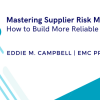How to Assess End-to-End Supply Chain Sustainability
For businesses across the globe, sustainability used to be a “nice to have,” but now the view has shifted. It’s a “must have — or else.”
There’s one reason for this: Governing organizations and regulatory bodies now see sustainability and ESG practices as business functions. The U.S. Securities and Exchange Commission announced in March 2021 the creation of a Climate and ESG Task Force, intended to protect investors from risk by proactively identifying ESG-related misconduct. The 2030 Agenda for Sustainable Development, adopted by all United Nations (UN) Member States in 2015, set 17 Sustainable Development Goals (SDGs) that were drawn up in collaboration with governments, business, civil society and citizens. Countries are encouraged to use these goals as a framework for establishing individual national plans, creating the likelihood some nations will issue new or more stringent regulations to encourage business sustainability.
Beyond governmental and regulatory requirements, businesses also face increasing consumer pressure to prioritize sustainability. IBM and the National Retail Federation (U.S.) surveyed 18,980 consumers in 28 countries and found nearly six in 10 consumers are willing to change their shopping habits to reduce environmental impact. Nearly eight in 10 respondents indicated sustainability is important to them.
Yet across all industries, many companies’ sustainability practices are not fully developed. A 2020 UN report found just 39% of companies believed they have targets sufficient to meet the SDGs by 2030; only 46% of businesses are embedding SDGs into their core business.
Global organizations that rely on multiple suppliers and lengthy supply chains as a part of their core business face some of the biggest barriers to achieving true sustainability. This is because some are unsure how to accurately measure a supplier’s sustainability, and because it’s challenging to look all the way down the supply chain to assess the sustainability of even second- and even third-tier suppliers — but neither are impossible to do.
How to Evaluate Your Suppliers’ ESG and Sustainability Credentials
Typical ESG parameters fall into four main categories:
- Environmental: CO2 and GHG emissions (i.e., emissions to land, water and air); water, fuel and energy usage; landfill rate; waste reduction and treatment; waste recovery (i.e., deriving energy from waste); by-products usage; recyclability and reuse; usage of renewable resources; biodegradable inputs/raw materials usage; transparency; certifications and standards; carbon credits, etc.
- Social: housing/living conditions; employment generated; health and safety; education; diversity and inclusion; etc.
- Financial: cost/benefit analysis; return on investment (ROI); etc.
- Governance: accurate and transparent accounting standards; voting rights for stockholders; etc.
As a caveat, every industry functions differently, so KPIs or measurement parameters and targets will differ among industries as well as individual organizations.
To create a comprehensive sustainability performance measurement process, the following steps and practices must be followed:
- Identify appropriate KPIs through a combination of understanding your supply chain and suppliers’ operations; studying and observing what your peers are doing; and determining the government regulations that impact your suppliers and your operations.
- Once KPIs are identified, companies need to understand both external and internal processes to set quantitative targets. External processes include the targets set by competitors, regulators and countries, as well as how your suppliers operate and how they’re performing now, based on the KPIs you’ve identified. Internal processes include your own sustainability performance as mapped against your target goals.
- Next, a supplier measurement scorecard should be created, and suppliers must be assessed and scored against it on a regular basis (preferably annually).
Don’t Forget Your Suppliers’ Suppliers
If it’s rare enough for companies to evaluate the sustainability and ESG practices of their preferred or main suppliers, it’s even more unusual for them to look at their suppliers’ suppliers.
But remember, the responsibility to be sustainable — and often the legal and regulatory onus — generally falls on the company at the top. Not understanding policies and practices for suppliers all the way down the supply chain is a business risk that can result in not only legal or regulatory fees, but also decreased revenues, loss of customer and investor trust, and sometimes a permanently tarnished reputation.
Some ways to create an understanding of your entire supply chain include the following:
- Ask your first-tier suppliers to disclose their suppliers’ names and, if applicable, any relevant industry certifications on manufacturing, distribution, quality and sustainability.
- Gain greater control over the supply chain by purchasing raw materials on your suppliers’ behalf or shortlisting raw materials suppliers for your input suppliers.
- In new business contracts, or as an addendum in an updated or renewed contract, include a stipulation that suppliers must use only suppliers that you know are certifiably sustainable.
- If your supplier discloses their suppliers’ company names, conduct your own research on these suppliers using news articles, reports from unbiased third parties, regulatory boards, financial reports, etc.
- Monitor news available in the public domain and your suppliers’ financials to gain access to any news that may mention their own suppliers.
- Outsource ESG research, monitoring, measuring and audits to a reputable third-party organization. This sometimes is the most effective solution from a cost and time perspective. The sheer volume of suppliers within some supply chains makes it very difficult to keep up with individual suppliers’ practices and activities on a regular, proactive basis; doing so also requires resources specifically allocated to ESG monitoring and measurement. Apart from expertise in creating ESG frameworks for your organization as well as regularly monitoring your suppliers, third parties also can offer ad-hoc custom intelligence across one or multiple industries of relevant sustainability trends, best practices, regulatory changes and benchmarks.
There is no one right way to design an effective sustainability measurement framework because every organization’s model must take into account the industry, supply chain complexity and the maturity of the organization, among other factors.
But it’s a necessary practice — even a must-have — for any organization that doesn’t yet have a framework in place. With regulatory agencies, investors and consumers alike keeping a closer watch on companies’ ESG practices, businesses that can measure and achieve sustainability throughout their entire supply chain will be positioned for success, now and in the future.









